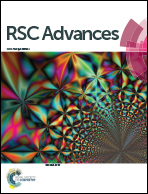Highly active electrocatalysts of iron phthalocyanine by MOFs for oxygen reduction reaction under alkaline solution†
Abstract
Metal–nitrogen–carbon materials (Fe–N/C) have been extensively studied as one of the most excellent electrocatalysts with good catalytic activities and cheap price towards the oxygen reduction reaction (ORR). The rational design of metal–organic framework (MOF) derived carbon materials with rapid mass transport ability and good stability is a great challenge to achieve. Herein, intensive research of Fe–N/C catalysts prepared from assembling MOFs with cheap iron phthalocyanine (FePc) for the ORR is innovatively carried out. A series of Fe–N/C nano-architectures are simply synthesized by a convenient assembling method under different temperatures (800 to 1000 °C). The assembly method at high temperatures tunes the number of FeNx active sites and intensifies the exposure of interior active sites. The highly dispersing Fe20–N/C electrocatalyst treated at 900 °C exhibits remarkable stability and excellent ORR activities with a half-wave potential of 0.866 V (vs. RHE) in alkaline solution, which is higher than that of commercial Pt/C (0.838 V vs. RHE) under the same test conditions. X-ray photoelectron spectroscopy results illustrate that incorporated MOFs interact with the active centre of FePc, tend to enhance the electron transition and to promote the kinetics of the ORR. Overall, highly dispersed Fe–N/C MOF-based materials are excellent non-precious metal electrocatalysts for energy and environmental applications.



 Please wait while we load your content...
Please wait while we load your content...